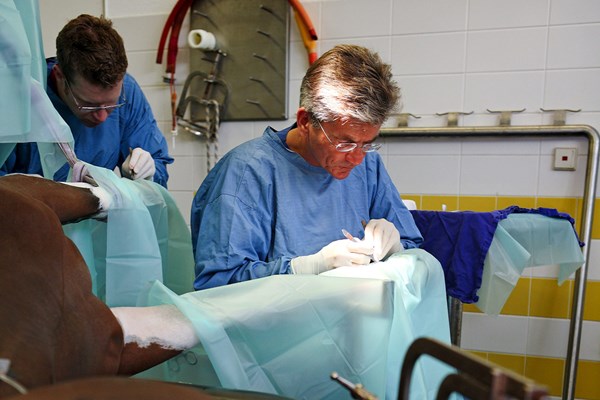 Credit: Arnd Bronkhorst Make sure you look for an associate whose communication and culture styles match the practice’s.
Credit: Arnd Bronkhorst Make sure you look for an associate whose communication and culture styles match the practice’s.Author’s Note: The referenced survey was created by the author to expand the profession’s knowledge of this topic. All of the veterinarians quoted in this article gave their permission to have their ideas included in this article.
Earlier this year, a short survey was posted on the AAEP Business Education community listserv to investigate how practice owners felt about their recent hiring experiences. Responses were collected from just 35 veterinarians, but their insights provide a window into the process of bringing on an associate.
Because job openings have been few in the last year or so, it was not a surprise that 46% of respondents had last hired an associate more than 12 months ago. 26% had hired an associate in the previous six months, and 29% had hired one 6-12 months ago.
The methods used by the respondents to attract applicants included website ads on sites such as AAEP, ACVIM and ACVS; ads in print journals such as JAVMA; current or previous intern contacts; and word of mouth. One respondent utilized an employment office at a nearby veterinary school, and several utilized social media.
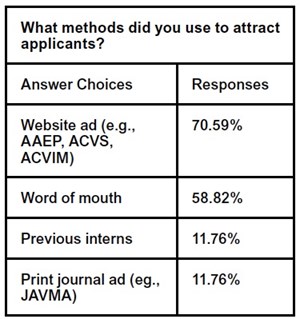
Soliciting Applications
Respondents were asked to choose all the methods that they employed to solicit applications for their job openings. The most popular choice was the use of website advertising, with 71% utilizing this method. Word of mouth was also quite popular, with 59% spreading the news to their colleagues to encourage applicants. Only 12% utilized print media advertisements. Interestingly, only 12% utilized contacts with current or former interns, but it is possible that the small sample size included owners without internship programs.
How Many Applicants?
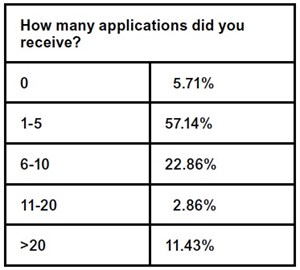
The majority of practices (57%) got 1-5 applications, with 23% receiving 6-10 applications. Despite the dearth of equine practice jobs and the plethora of equineoriented graduates, only 11% of practices got more than 20 applications.
Because practices often seek to hire before the start of another busy season, they are typically looking to bring someone on board during the late winter. Internships generally are completed in June, as the busiest months of equine practice are beginning to taper off. This mismatch in need versus availability might play a part in the number of applications that are received.
Despite the relatively low numbers of job applicants, 68% of respondents indicated they were satisfied with the number of applications received.
Qualifications of Applicants
The quality and qualifications of the applicants were satisfactory to 68% of the respondents, and unsatisfactory to 32%. A strong majority (60%) interviewed just 1-2 candidates on site at their practices, perhaps indicating they felt confident in initially judging suitability via a phone conversation. Thirty-one percent interviewed 3-5 candidates, and 9% interviewed more than five candidates in person at their practices.
Happily, knowing what they know now, 76% of the respondents are pleased with their hires and would choose to hire them again. Unfortunately, 24% of the responding practice owners are dissatisfied and would not hire their associates again with what they have now experienced or observed about their employees.
One veterinarian who recently hired an associate expressed dismay with the applicants he recruited and interviewed through traditional means, but found success through word of mouth. He said, “I hired my last associate two years ago. I advertised on the AAEP website only and received greater than 50 applicants. I even had two surgeons, four internists and two theriogenologists apply. I interviewed 30 by telephone and asked 15 to visit the practice. In the end, I didn’t want to hire any of them.
“Then I got a call from a fellow VMG (Veterinary Management Group) member. He had an intern who had left a year ago, and he said he would love to hire her himself if he had an opening. She came to visit our practice and spent a week with us. We loved her and offered her the job. Two years later, we still love her, the clients love her and she just bought a house. We hope in the future she will buy my shares and become my partner’s partner.”
This practice owner’s experience speaks to the power of word of mouth in pairing young veterinarians with practices that suit their personalities and skill sets.
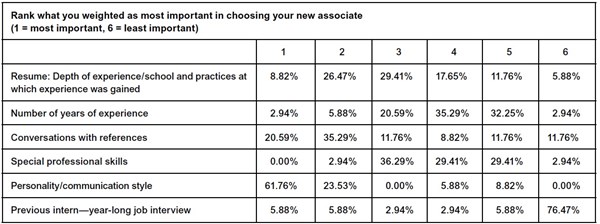
Most Important Attributes
The practice owners who responded to the survey were asked to rank what they considered most important among the attributes of their potential new associates. Having a personality and communication style compatible with the culture of the practice was considered the most critical factor by 62%, and was ranked second in importance by 24%. In other words, 86% of responding employers value this intangible and highly personal quality very highly.
Conversations with applicants’ references were considered the most important factor in their decision by 21% of respondents, and the second most important factor by 35%. It is clear that applicants should choose their references carefully to be sure they can speak fully to the candidate’s strengths and interests.
Of note was the finding that the strength of the resume and depth of experiences were ranked as more important by respondents than simply the number of years of experience. In fact, years of experience ranked similar in importance to the applicants possessing special clinical skills such as acupuncture certification.
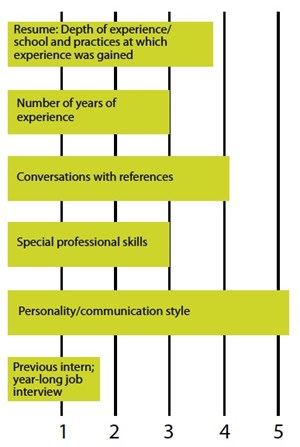
Although previous internship at the hiring practice was ranked lowest of the choices, it is uncertain whether this was a valid result or resulted from the responding practices simply not having internship programs, as “not applicable” was not given as a choice in the survey. A question that needs to be answered is, “If you have interns and begin looking for an associate, how more or less likely are you to hire a previous/existing intern from your practice compared to another candidate?”
The survey prompted a robust discussion on the AAEP Business Education community listserv. Former AAEP President Dr. John Mitchell offered the following comments: “Past AAEP President Clyde Johnson often says, ‘Never hire an associate that you would not want as a partner.’ I think there are three main reasons why this was good advice:
1. If the associate does not meet the character and culture of the practice, it will probably not be a productive time for the associate, the clients or the practice partners—these hires usually do not have a happy ending.
2. When you hire an associate that does not meet the standards of potential to become a practice partner, the practice misses an opportunity to get to know better a different partner candidate. One always hopes that the good ones also grow to like the practice enough to want to develop as a partner. There are only so many hiring opportunities, and every intern and associate should be hired as a potential practice partner.
3. A good retirement often depends on a good exit strategy, and what better way to have a good exit strategy than to be surrounded by a like-character group of successful associates waiting to buy into a practice? I realize the intern-associate-partner buy-in and the buy-out of retiring partners is not as easy and as common as in previous decades, but I think it is still a good standard to try to adhere to.”
A counterpoint was stated by recent graduate Dr. Joe Pluhar, who said, “I do not believe a hiring decision should hinge on whether or not someone is willing to buy in. A hiring decision should be made based on character, cultural and skill fit with the practice, not based on how long someone will be there. I believe a business is better off having someone great for a short time than someone mediocre for a long time.”
Many experienced practice owners will recognize that this idea, while not an uncommon one, often leads to lowered client satisfaction and higher training and marketing costs. Horse owners bond to a doctor, only to be disappointed when he or she departs from a practice. Then, time and money has to be spent on another recruiting, interviewing, orienting and marketing cycle for each new doctor.
“The differences between generations have to be considered,” Pluhar continued. “My class (class of 2014) was asked how many of us saw ourselves owning a practice. Approximately 20% said they did. This is a tectonic shift from previous generations where 80% said they wanted to own a practice. A lot of these younger veterinarians are going to make great associates, but they do not want to join the ranks of practice ownership for a variety of reasons. They can still provide a lot of value to a practice.”
Take-Home Message
Whether simply seeking fabulous associates or trolling for potential partners, the practice owners that responded to this survey make hiring decisions based on “best fit” for their practices’ unique cultures, utilizing the strength of their networks of colleagues to find the best candidates, and thoroughly investigating their potential hires through conversations with references. This sensible approach is one that is likely to yield the best outcomes for all parties.
Because of the importance of this topic, EquiManagement and EQUUS will host Dr. Grice to present “How to Attract and Retain Associates” on Sunday Dec. 6, 6:30-7:45 a.m., in Breakers EF at the AAEP Convention Center during the AAEP Partners’ Sunrise Sessions.








